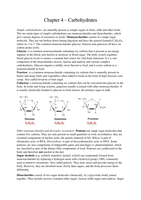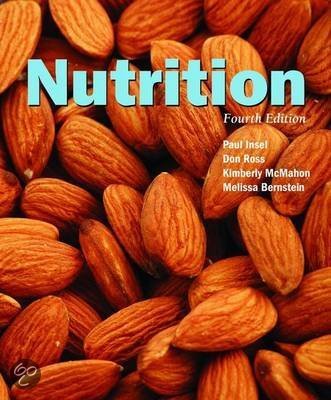Chapter 4 – Carbohydrates
Simple carbohydrates: are naturally present as simple sugars in fruits, milk and other foods.
The two main types of simple carbohydrates are monosaccharides and disaccharides, which
give various degrees of sweetness to foods. Monosaccharides consist of a single sugar
molecule. They are not broken down during digestion and have the general formula C nH2nOn,
where n= 3 to 7. The common monosaccharides glucose, fructose and galactose all have six
carbon atoms (n=6).
Glucose: is a common monosaccharide containing six carbons that is present as an energy
supplier in the blood; also known as dextrose or blood sugar. The body closely regulates
blood glucose levels to ensure a constant fuel source for vital body functions. It is a vast
component of the disaccharides sucrose, lactose and maltose and various complex
carbohydrates. Glucose imparts a mildly sweet flavour to food, and it exists seldom as a
monosaccharide in food.
Fructose: is a common monosaccharide containing six carbons that is naturally present in
honey and many fruits and vegetables; often added to foods in the form of high-fructose corn
syrup. Also called levulose or fruit sugar.
Galactose: a monosaccharide containing six carbons that can be converted into glucose in the
body. In foods and living systems, galactose usually is joined with other monosaccharides. It
is usually chemically bonded to glucose to form lactose, the primary sugar in milk.
Other monosaccharides and derivative sweeteners: Pentoses are single sugar molecules that
contain five carbons. They are only present in small quantities in food, nevertheless, they are
essential components of nucleic acids, the genetic material of life. Ribose is part of
ribonucleic acid, or RNA. Deoxyribose, is part of deoxyribonucleic acid, or DNA. Some
pentoses are also components of indigestible gums and mucilages [= plantenslijmen], which
are classified as part of the dietary fiber components of food. Pentoses are synthesized in the
body and therefore not needed in the diet.
Sugar alcohols (e.g. sorbitol, mannitol, lactitol, xylitol) are compounds formed from
monosaccharides by replacing a hydrogen atom with a hydroxyl group (-OH); commonly
used as nutritive sweeteners. Also called polyols. They taste sweet and provide energy to the
body. However, they are absorbed more slowly than sugars, and the body processes them
differently.
Disaccharides consist of two sugar molecules chemically, by a glycosidic bond, joined
together. They include sucrose (common table sugar), lactose (milk sugar) and maltose. Sugar






